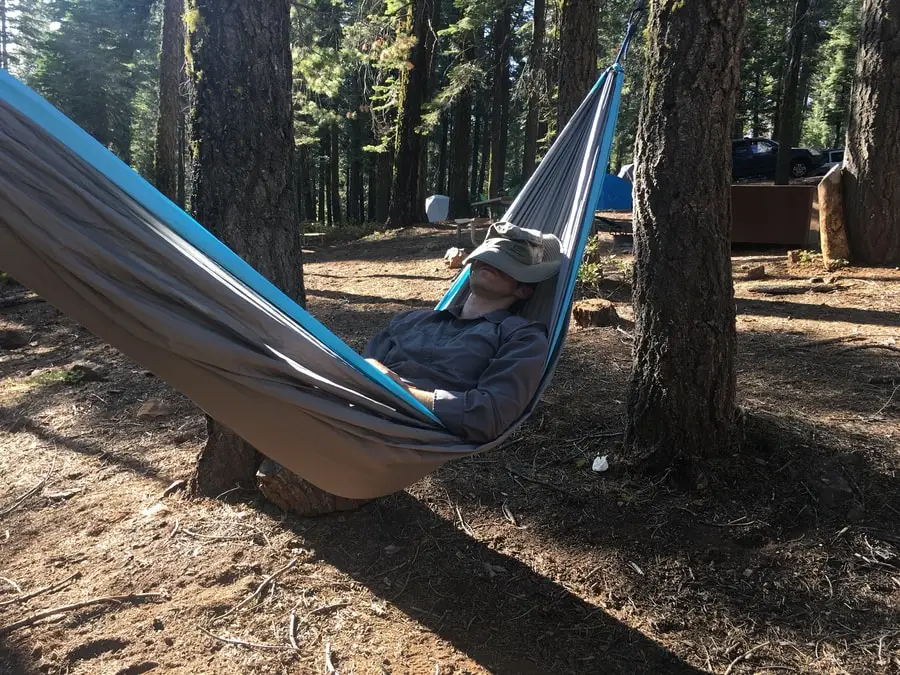
Hammocks are comfortable, but will they keep you warm at night if you sleep in them? You might have wondered this, I did when I first started sleeping in hammocks. I did my research on this one, read on if you want to learn how to camp in a hammock successfully.
So, are hammocks warmer than tents? Hammocks are generally colder than tents because they are less useful for preventing wind chill without other hammock warming accessories.
Wind chill will make your hammock feel much colder than a tent. A tent keeps the air inside of it relatively stagnant, which helps keep your warm body heat close to you. A hammock allows cool air to pass through your body, which keeps you colder. There are some ways that you can reduce the chilliness of a hammock, although it may never be as warm as a well-designed tent. Sometimes this is an advantage if the outside air is particularly warm, then the hammock would have the upper hand.
By the way, If you are in the market for a new hammock, then you should click here to see the one I recommend on Amazon.
What Is Wind Chill?
Wind chill is the lowering of your body temperature due to wind passing through it with air that is cooler than your body heat and thus stripping some of your body heat from you. It is the reason why it seems much colder on windy days than on stagnant days. Wind chill is the reason why most online weather sites will display the temperature, but also display a “feels like” temperature. The feels like temperature includes any windchill factors.
Hammocks do not do a good job and reducing wind chill when you are lying in them, at least not alone. Tents, on the other hand, keep the air inside of them relatively stagnant and so your body heat remains the same because there is no breeze to whisk away your body heat. This is a very important component of staying warm in cooler temperatures. Your goal is to reduce body heat loss through various methods. It’s a big part of the reason why we sleep in tents, on sleeping pads, and in warming layers.
How much colder is a hammock than a tent?
It really is impossible to tell how much colder a hammock is than a tent because there are many factors to consider. The main factors are of course air temperature and wind speed. A popular rule of thumb to consider is that a hammock is about -20°F cooler than a tent. If you want to try and calculate your own wind chill factor, then you can use the formula below:
Wind Chill (F) = 35.74 + 0.6215T – 35.75(V^0.16_ + 0.4275T(V^0.16)
where T = air temperature (F) and V = Wind Speed (mph)
It’s pretty complicated stuff and not really worth your time, to be honest. You are better off using the -20°F cooler assumption or better yet just going by how you feel when lying in your hammock. If you are considering trying to camp in your hammock overnight then luckily there are ways that you can increase the warmth in your hammock and make it like a tight warm cocoon. Besides, why would you not, hammocks are so comfortable that they have the ability to make you take naps during the day, and so they will give you a good nights sleep if you are able to stay warm.
How to stay warmer in a hammock
Luckily for us, there are ways to stay warmer in a hammock and enjoy the comfort of sleeping in one all night long when we go camping. In order to do so, we will need some extra gear that can assist us in keeping warm.
The first is an underquilt. Underquilts provide bottom insulation for your hammock. A hammock alone will let a lot of cold air pass through its then material under you. This is why your bottom area gets particularly chilly when lying in a hammock. Bottom insulation is essential for preventing this heat loss in a hammock. An underquilt is like the hammock version of a sleeping pad for a tent. The underquilt will not sacrifice comfort and will keep you very warm compared to being bare bottom.
Speaking of sleeping pads, they can be used in place of an underquilt in a pinch, but you will sacrifice a lot of comfort, and they won’t work as well as a real underquilt. They are able to provide some bottom insulation in your tent. If it is an inflatable sleeping pad then it will need to be mostly deflated to allow it to conform to the shape of the hammock. Closed-cell foam sleeping pads can also work inside of the hammock as bottom insulation, but again, you will sacrifice some comfort compared to an underquilt. Sleeping pads are still great and versatile and I think that every one that is interested in camping should have at least one.
The next piece of gear that you will need to keep you warm in your hammock is your sleeping bag. The sleeping bags will prevent a lot of heat loss by trapping your body heat inside of it with you. They do not work alone however so it is important to remember that a sleeping bag without bottom insulation is heavily negated. Sleeping bags need to be paired with bottom insulation to work well, especially in a hammock.
With that being said, you may need a warmer sleeping bag in a hammock than you would in a tent, especially if there is nothing above you to block the wind. Normal summer rated sleeping bags might not be able to suit your needs enough. I always recommend most campers go with a 3-season sleeping bag for their versatility. So if needed, consider getting a higher rated sleeping bag for camping in a hammock if you need to.
Last but not least, another way to stay warm in your hammock is by creating a barrier above you. It is like you are making your own tent around your hammock. The idea is to deflect wind that would otherwise blow straight into you. In order to be effective, try to set your hammock closer to the ground and use a hammock tarp to completely cover you. If you can get a sense of wind direction and use the tarp to deflect it then even better. In addition to wind protection, a hammock tarp can provide you with protection from rain, snow, sunlight, and provide some privacy.
Before I forget, another essential element to staying warm no matter where you are planning to sleep is warm clothing. Wearing proper warming layer can make or break a good night’s sleep when camping, whether you are in a hammock or in a tent. Don’t forget things like nice wool socks, knit hats, and thermal undergarments.
When sleeping in a hammock makes more sense than a tent
Sometimes it just makes more sense to sleep in a hammock instead of a tent. For one, it can be much more comfortable. You probably know how dangerously comfortable hammocks are. If you enjoy lounging in a hammock and like sleeping on your back then consider trying to sleep in a hammock overnight when camping.
When it’s particularly hot at night it can be nice to sleep in a hammock. Hammocks are much cooler than tents. If your out in the desert on a warm summer night then lying in a hammock could be a nice cool change. Hammocks allow air to pass through them and thus would keep you cooler on a warm night. Without any warming gear, a hammock alone only would work well in temperatures of 65°F-70°F and above but of course, this all depends on your individual preferences.
Should I try camping in a hammock?
Yes, of course, you should try it. If you enjoy camping and you enjoy lying in a hammock then you should try camping overnight in one. It’s much easier to try in the summer with warmer temperatures, but if it is a bit cooler where you are, do not worry, with the right gear such as an underquilt, a good sleeping bag, a hammock tarp, and proper warming layers you can enjoy a great night’s sleep in a hammock
Conclusion
So while hammocks are not warmer than tents they can be made warm enough to sleep in. With the proper gear, you can camp comfortably in a hammock. Your biggest obstacle is to reduce wind chill, something that a tent naturally does. Luckily, it is easy to do with a hammock and it could allow you to sleep better in a comfy hammock all night long
My Favorite Camping Gear
- Air Mattress: click here
 to check out my favorite on Amazon.
to check out my favorite on Amazon. - Tent: click here
 to see my favorite tent available on Amazon.
to see my favorite tent available on Amazon. - Sleeping Pad: click here
 to check out the one I love on Amazon.
to check out the one I love on Amazon. - Sleeping Bag: click here
 to see the one I recommend on Amazon.
to see the one I recommend on Amazon. - Camping Stove: click here
 to see the best camping stove on Amazon.
to see the best camping stove on Amazon.
.

